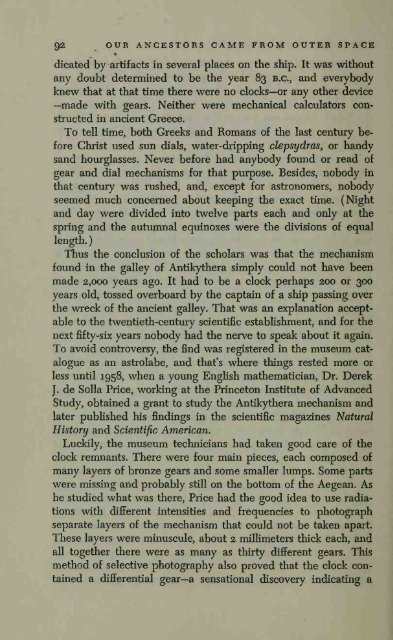Create successful ePaper yourself
Turn your PDF publications into a flip-book with our unique Google optimized e-Paper software.
)<br />
92 OUR ANCESTORS CAME FROM OUTER SPACE<br />
•<br />
dicated by artifacts in several places on the ship. It was without<br />
any doubt determined to be the year 83 B.C., and everybody<br />
knew that at that time there were no clocks—or any other device<br />
—made with gears. Neither were mechanical calculators constructed<br />
in ancient Greece.<br />
To tell time, both Greeks and Romans of the last century before<br />
Christ used sun dials, water-dripping clepsydras, or handy<br />
sand hourglasses. Never before had anybody found or read of<br />
gear and dial mechanisms for that purpose. Besides, nobody in<br />
that century was rushed, and, except for astronomers, nobody<br />
seemed much concerned about keeping the exact time. (Night<br />
and day were divided into twelve parts each and only at the<br />
spring and the autumnal equinoxes were the divisions<br />
of equal<br />
length.<br />
Thus the conclusion of the scholars was that the mechanism<br />
found in the galley of Antikythera simply could not have been<br />
made 2,000 years ago. It had to be a clock perhaps 200 or 300<br />
years old, tossed overboard by the captain of a ship passing over<br />
the wreck of the ancient galley. That was an explanation acceptable<br />
to the twentieth-century scientific establishment, and for the<br />
next fifty-six years nobody had the nerve to speak about it again.<br />
To avoid controversy, the find was registered in the museum catalogue<br />
as an astrolabe, and that's where things rested more or<br />
less until 1958, when a young English mathematiciEin, Dr. Derek<br />
de SoUa Price, working at the Princeton Institute of Advanced<br />
J.<br />
Study, obtained a grant to study the Antikythera mechanism and<br />
later published his findings in the scientific magazines Natural<br />
History and Scientific American.<br />
Luckily, the museum technicians had taken good care of the<br />
clock remnants. There were four main pieces, each composed of<br />
many layers of bronze gears and some smaller lumps. Some parts<br />
were missing and probably still on the bottom of the Aegean. As<br />
he studied what was there. Price had the good idea to use radiations<br />
with different intensities and frequencies to photograph<br />
separate layers of the mechanism that could not be taken apart.<br />
These layers were minuscule, about 2 millimeters thick each, and<br />
all together there were as many as thirty different gears. This<br />
method of selective photography also proved that the clock contained<br />
a differential gear—a sensational discovery indicating a

















